Guitar Parts Names
Knowing The Body And Neck Parts Of Your Instrument

Before you start trying to make noise, it is important that you are familiar with all the names of the parts of a guitar, how they work and interact with each other, and how to take proper care of the whole instrument.
In this tutorial, you're going to learn the name of all the devices that compose your axe.
Whether acoustic or electric, your guitar has many mechanical parts that you should be aware of. If you're interested in learning about the ancient relatives of guitars, you can explore them here.
Electric or Acoustic First?
I usually recommend that new students learn on an acoustic guitar first, because an electric guitar has a lot more parts , more maintenance requirements, and more things to have to fool with.
I figure that a new student already has enough to do just trying to learn to play, but that is just me.
If you are set on learning on an electric guitar, then you need to know your weapon .
Main Differences
The main difference between an electric guitar, and an acoustic is that the sound of an acoustic is shaped by the type of wood or woods it is made from, the type of internal bracing it has, and the basic design, such as a rounded back, large sound chamber, etc.
A solid-body electric guitar gets 90% of its sound shape from the pick-ups , and how they are set up and adjusted, in addition to the amplifier settings.
Electric Guitars
An electric instrument requires extra equipment, such as chords, and an amplifier, but the advantages are that even with an inexpensive electric guitar, you can get just about any sound you want, by adjusting the controls on the guitar and amplifier .
You can also add external effects .
With an acoustic, you are pretty much stuck with what you have bought.
The only recourse is to get another acoustic guitar if you're not happy with the sound of your current one.
Another advantage of electrics is that there is not as much difference between a high-priced model, and the more modestly priced ones .
The more expensive ones will certainly have a better fit and finish, and will be set-up better, but a solid-body electric guitar is basically just a piece of wood with electric pickups attached to it.
Chances are, that $1000.00 Gibson SG beauty you saw in the last Musician's Friend catalog has the same, or similar pick-ups as the $199.00 Fender Squire from Sweetwater Music.
For the extra money, you are mostly getting prestige , maybe a little better electronics , and a more refined set-up. You can always change the electronics in your current guitar if you need or want to.
I'm particularly impressed with some of the inexpensive models from Fender Squire, and Ibanez.
They sound great, play well, and many are available for under $250.00, brand new.
Electric Guitar Parts Names
It is important for you to know and understand the basic parts of your guitar.
For this article, I am going to assume you already have a solid-body electric guitar.
We'll cover arch-tops and hollow-body electrics in future posts.
Lets start by getting familiar with the basic parts of your electric guitar.
You need to know what each one does so if there is a problem, you can trace it down, and repair it yourself , or at least know what to tell a technician.
You need to know how to make basic adjustments, do basic maintenance, how to change strings properly , etc..
Main Guitar Parts
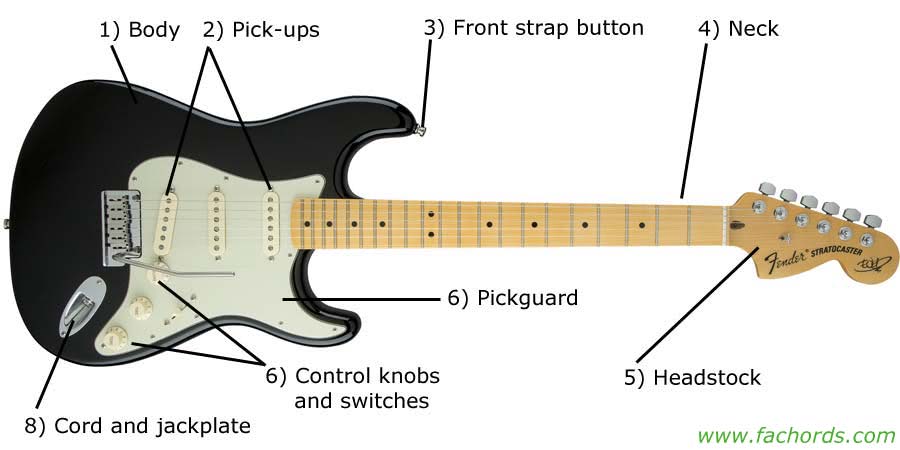
Main parts of an electric guitar
- Body : Usually made from ash or mahogany. The body is mainly just something to mount electronics and parts to, and something to hang on to.
- Pick-ups : Magnets with wire wrapped around them. These convert string vibration into electrical impulses, that the amplifier turns into sound.
- Front Strap Button : This is where you attach the end of a strap, and/or strap-lock system.
- Neck : Where you make the notes. The neck is covered with a fretboard, usually made from maple or rosewood, into which frets are embedded.
- Headstock : holds the tuners and it is where the top of the strings are wrapped.
- Pickguard : mostly for decoration, and covers the control cavities where the wiring is.
- Control Knobs and Switches : adjustments for the pickup controls, usually volume, tone and a pickup selector switch.
- Cord and Jackplate : where the cord goes in to feed signals to the amplifier.
Neck Parts
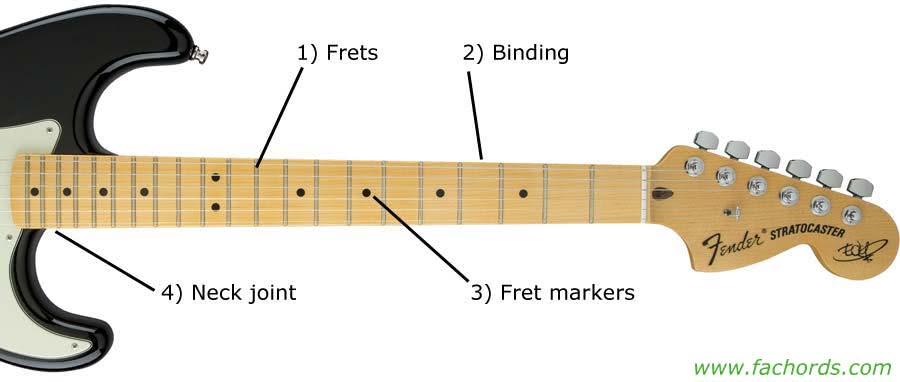
Neck parts
- Frets : usually made from nickel-silver, or nickel copper wire, these wires are embedded into the fretboard, and are what actually makes the notes.
- Binding : decorative plastic, bone, or abalone inlay along the sides of the neck. Provides a semi-slick surface to slide your hand along while playing.
- Fret Markers : positional dots inlaid into the fretboard to help you know what fret you are playing on. Usually set at frets 3, 5, 7, 9, 12, etc.
- Neck Joint : where the body and the neck meet. This determines the scale of your guitar, either long, or short scale. Neck joints can be Bolt-On, a Set Neck, or Neck-Through. Each type has advantages and disadvantages. Bolt-On is the most prevalent type.
Headstock Parts

Headstock parts
- Nut : made from plastic or bone, this routes the strings down the neck, and is one of the things that determines string spacing.
- Tuning Knobs : these are what you turn to raise or lower the pitch of a string. They are usually attached to a gear system which turns the tuner shaft. Most modern tuning mechanisms are sealed and require little maintenance. There is a small screw in the top of the tuning knob to let you tighten the nob if it becomes loose.
- Tuning Posts : this is what the top of the string wraps around. There is a retaining nut at the base. This is what you tighten if your shaft becomes wobbly.
- String Retainers : these supply downward tension on the thinner strings to help keep them from popping out of the string slots in the nut during aggressive playing.
- Truss Rod Adjustment : usually an Allen nut, and may be covered with a plastic plate to keep out dust and debris. This adjusts the neck relief, or neck straightness. This is not how you set the action of your guitar, contrary to what you may have heard. It is only for adjusting the bow of the neck. Action is adjusted by the nut and bridge height.
- Strings : what makes all the noise. Can be Bronze, Phospher-Bronze, or Stainless Steel. There are some other exotic metals used to make strings as well. They come in different gauges, and string gauge will effect how your guitar sounds and plays.
Body Parts
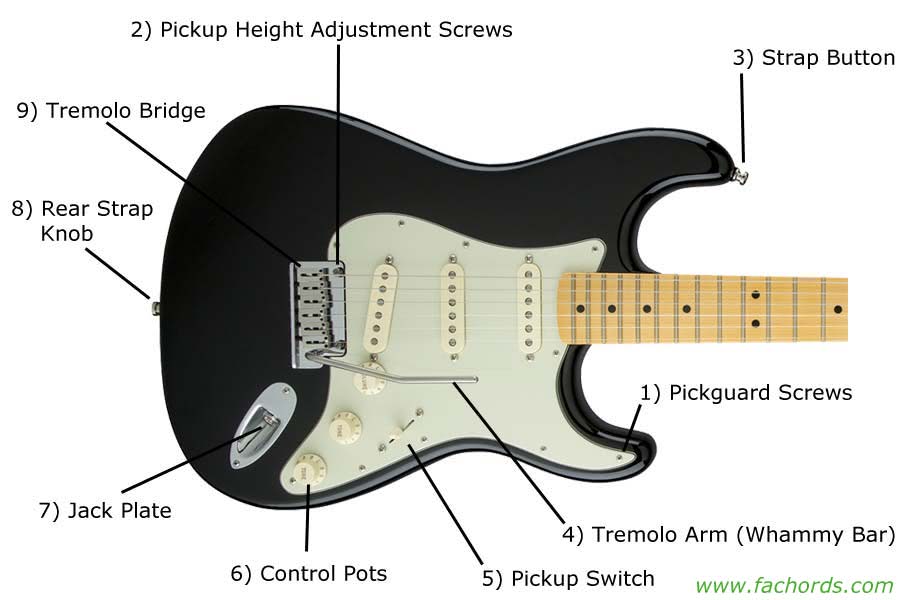
Main body electric guitar parts
- Pickguard Screws : these tiny screws hold the pickguard on, and are frequently lost, so it's a good idea to keep plenty of spares on hand....
- Pickup Height Adjustment Screws : these allow you to adjust the height of your pickups for different sounds. Raising the pickup will make it louder, and have more attack. Lowering it mellows the sound out.
- Strap Button : where you attach a strap and/or strap lock systems.
- Tremolo Arm (Whammy Bar) : used to temporarily raise, or lower the pitch of the strings, and for sliding into and out of notes.
- Pickup Switch : used to select which pickups you are using at the time. Can be used to select single pickups, and combinations, depending on how it is wired. It can be a three, or five position switch.
- Control Pots : these control tone and volume of the pickups. Some can be pulled out to make the pickups active, or out-of-phase, depending on how they are wired.
- Jack Plate : where the cord plugs in. If your guitar makes a hum when you take your hands off the strings, it is usually due to the jack plate not being grounded properly...an easy fix. If it's not the jack plate, then it is the control cavity shielding, which is a lot more trouble to repair. Always check the jack plate first, and over 60% of the time, that is where the trouble will be.
- Rear Strap Knob : same as the front one....it is where you attach your strap and/or locking system.
- Tremolo Bridge : there are two main types, the Fulcrum, which has few moving parts and is very reliable within a limited range, and a Floating Trem Bridge, which uses springs in the rear, and allows for totally insane string bending. It does require some adjustment to work properly. A third kind, the Bigsby, is ultra-reliable, almost indestructible, and maintenance-free. We'll address these in future articles....
Bridge Parts

- Saddle Height Adjustment Screws :this is one of the places where you set your action.This allows you to adjust each individual strings height above the fretboard for a customized action. String height on the upper end is adjusted by filing the nut down, or adding shims.
- Intonation Adjustment Screws :this sets the string length for each string so that it will fret true all the way up the neck. This adjustment is best left to someone with a good chromatic tuner, and some know-how. We'll discuss this in future articles.
- Bridge Saddles : these cradle the end of the strings and allow for individual adjustment of string height and intonation.
- Tension Springs : these apply back pressure to the Intonation Adjustment Screws so that they will push the string saddles when the screw is loosened, otherwise, the screw would not work.
- Bridge Mounting Screws : these hold the bridge to the body. The bridge is under a lot of pressure from the strings, so you want to be sure all the mounting screws are there, and they are snug. They just need to be snug. Over-tightening them can strip out the wood, and ruin your guitar.
Body Rear Parts

Guitar Body rear parts
- Tuner Housings : these contain the gear mechanisms for the tuners. While it is possible to remove them to oil the gears, and replace worn-out parts, it is easier and cheaper just to discard the whole tuner and replace it.
- Neckplate : on Bolt-On necks, this covers the screws that hold your neck to the guitar. It's not a bad idea to remove this cover and check the screws once in a while, and tighten them if they are loose. I check mine about once a year.
- Backplate : this covers the cavity that holds a Floating Bridge. It gives access to the tension springs, anchor plate, and the string routing channels. Some guitars also have a backplate that allows access to the rear of the control knobs and switch wiring.
This is what is underneath your backplate:
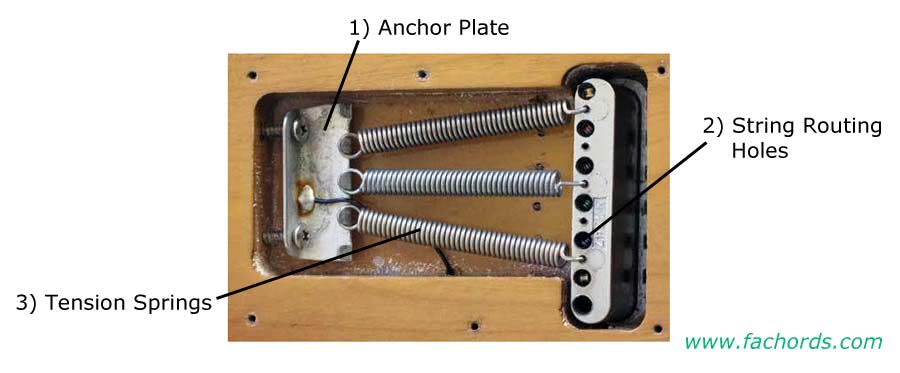
Underneath the backplate
- Anchor Plate : this is what holds the bridge to the guitar body, and is usually held on with just 2 screws, which also control the tension on the springs.
- String Routing Holes : this is where your strings get threaded through on a floating bridge.
- Tension Springs : these apply back pressure on the bridge so that (hopefully) it will return to normal pitch when you release the Tremolo Arm. If it doesn't, then you need to tighten the Anchor Plate mounting screws to increase the tension. Eventually, the springs will wear out and need to be replaced, but it is an easy job.
Pickups and wiring
Now you have a good working knowledge of what is contained in your guitar and its parts names, and hopefully, it is not so mysterious anymore.
An electric guitar is a marvel of engineering.
Even though all the mechanical parts and electronics are very basic, they allow for a complete customization of everything on your guitar, something that is not possible with an acoustic.
Humbucker
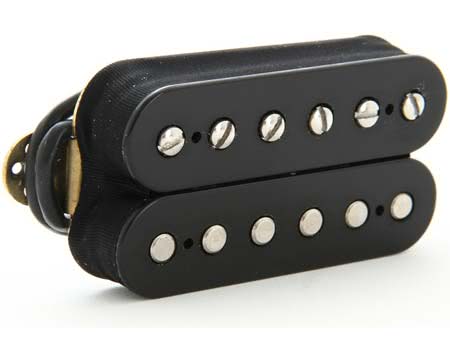 The
Humbucker pickup
coud be just two single-coil pickups wound in opposite directions from each other.
The
Humbucker pickup
coud be just two single-coil pickups wound in opposite directions from each other.
This cancels out electronic ‘hum' and give a warmer sound .
Hers are mounted side-by-side, which is the most common type, but they also make "stacked" humbuckers , one on top of the other, that can fit is a single-coil guitar cavity with little or no modification...neat, huh?
Pickup for lead guitar
When someone talks about "lead" and such, regarding the pickup selector switch, what he/she means is that the closer to the bridge the pickup is, the more high notes are expressed .
It's not necessarily for "lead", but for when you want more high frequencies to come to the front.
Moving to the pickups closer to the neck evens out the frequencies so that the lows come out more, and the sound becomes somewhat softer.
Blues and jazz musicians commonly play leads with the neck pickups, and I prefer to use the middle and neck pickups together, most of the time.
I only use the bridge pickup for twangy country and surf music leads .
Pickup out of phase
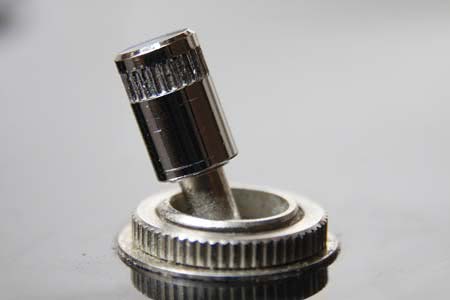 The
"out of phase"
position is a custom wiring feature.
The
"out of phase"
position is a custom wiring feature.
Out of phase is when the polarity of one side of a humbucker, or one single coil pickup when in combination with another, is reversed.
This result in a smoother, more mellow, ‘open' sound .
Switching from out-of-phase to in-phase increases the volume, and makes the sound harsher. Jimmy Hendrix and Robert Plant of Led Zeppelin made good use of playing out-of-phase.
Out of phase wiring is not unique to Strats, but it is a unique way of wiring a 5-way switch, which many guitars have.
This is not possible with a 3-way switch, such as those on stock Telecasters , and similar models. Normally, on a 5-way switch, the second position is wired to use the bridge pickup, and the middle pickup together.
Position 3 is just the middle pickup, position 4 is the middle and neck pickups, and position 5 is the neck pickup.
There are many custom wiring options available.
Some electric guitars have a piezo pickup mounted under the bridge for an acoustic-like sound, and this pickup is also wired to the 5-way switch.
There are many ways a 5-way switch can be configured.
Volume and tone knobs
 You may wonder why there is only one volume knob and two tone knobs. Many guitars, like my
Gibson Les Paul
, actually have 2 volume, and 2 tone knobs.
You may wonder why there is only one volume knob and two tone knobs. Many guitars, like my
Gibson Les Paul
, actually have 2 volume, and 2 tone knobs.
The switch allows for using two pickups at a time, so you have a volume and tone control for each pickup, so you can blend them and tailor your sound.
However, there is a tone knob for each pickup, so they can be blended when used in tandem with each other. Guitars with 3-way switches often only have 1 volume and 1 tone knob.
The Bridge
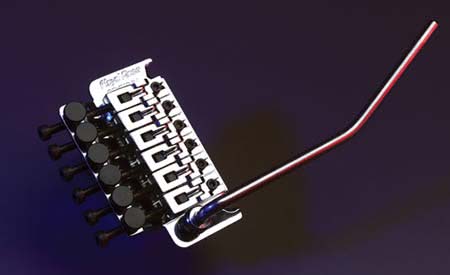 A guitar can have a
Fulcrum Tremolo Bridge
, which does not have the springs in the back.
A guitar can have a
Fulcrum Tremolo Bridge
, which does not have the springs in the back.
The amount of pitch variation you can do with this type of bridge is limited (but enough for most of us...).
"Dive-Bombing" is aggressive and radical pitch shifting, more than one whole tone , so much so that guitars with this kind of bridge have to have string locks at the nut to keep the extra string tension from pulling the strings loose at the tuning posts.
This is only possible with a floating tremolo bridge, such as those made by Schaller .
All floating bridges have springs in the back, otherwise they would not work.
If tuning your guitar is too big of a pain, you can have a technician put a bridge block in the back that keeps the springs from moving at all (rendering your tremolo bridge inoperative), so that your guitar can be tuned normally.
You can also do this yourself, but it is better to just replace the bridge with something like a Tunomatic , or Fulcrum bridge. Another great option is replacing it with a Bigsby Vibrato bridge .
On the plucking hand, the modern designations are P-I-M-A-D . D is the pinky finger.
If the pitch gets higher , you are moving up the neck. When the pitch is lowered , you are moving down the neck. Easy, huh?
Acoustic and Electric Guitar Strings
Heavier gauge strings are not necessarily harder to play on if your guitars action is set up for them.
Most models of guitars are designed to use a certain gauge of string. Too heavy a string will over-stress the neck and make it bow over time.
Too light a gauge will not supply enough tension , and the neck will bow backwards, in time.
There is a little room to play with, such as using light-medium strings on a guitar designed for light strings, etc.
Super-Light gauges are mainly meant to be used with floating bridges, where the tension will be variable.
A heavier gauge will give you a more mellow, darker sound, and the strings will bend less.
I use Medium Jazz strings on my Gibson Les Paul, because it was designed to use medium strings, and the heavier gauge takes full advantage of the hollow body for a beautiful bell-like sound.
I use light-mediums on my Stratocaster, and Telecaster because that's what they were designing to use.
The lighter gauges take advantage of the single-coil "bite" and attack for a twangy wail that cuts through the other sounds on stage.
A Few Words on Skin acidity
Actually skin acidity is not a big problem, if you remember to wipe your strings off with a good degreaser like Windex after you are finished playing, every time.
At least wipe them off with a soft cloth or paper towel.
This makes your strings last double the time.
You should also be using talcum powder on your hands when you play, both to increase speed, and protect the strings from your skin acid and salts.
It also protects the fretboard , which also suffers from salt build-up.
In my opinion, coated strings sound horrible , do not last much longer, and are more expensive than a decent set of normal strings.
Plastic will not make up for a lack of proper care on your guitar.
Do it the right way from the first, and you'll have few problems later on.
How To Tune Your Guitar
 In the next section, tuning is pretty straight-forward.
In the next section, tuning is pretty straight-forward.
The names of the strings (EADGBE) are only applicable if your guitar is tuned to International Concert Pitch (A=440 Hz). If your guitar is tuned down a whole step , then the strings would be DGCFAD .
You should really be using a tuner , either a physical unit, or one of the free ones online .
I even have a tuner on my cellphone.
But if for some reason a tuner is not available, then manual tuning is fine, as long as you can get one string to the proper pitch, by tuning it to a piano, or other instrument, a pitch pipe, or if you were lucky enough to be born with "Perfect Pitch" ears, and there are people like that.
I have met a few, but they are rare indeed. The irony is most of them I know only sing.
Once you have any string to pitch, you can tune the others to it with the comparative Method .
Remember, this only works if you can get one string to proper pitch (A = 440 Hz), also known as International Concert Pitch.
I, on the other hand, keep my guitars tuned down 1/2 step to make them more amendable to some of the alternative playing styles I use, and this is fine, as long as you are doing it on purpose.
You need to learn the correct way at first, then you can modify things to your liking later on.
As a rule, your guitar should always be tuned to Concert Pitch , in order to maintain proper string tension on the neck, and be doing the songs in the correct keys.
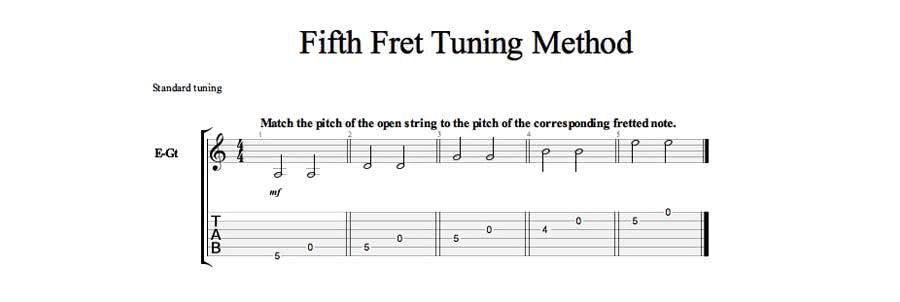
Always use a strap!
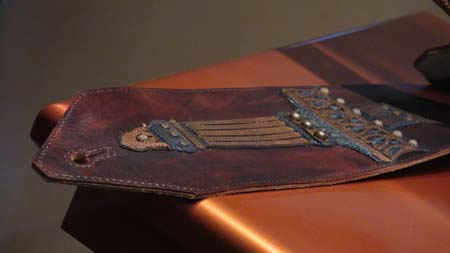
You should never play without a strap. More guitars are damaged, and destroyed , by being dropped, than by any other incident.
Straps are cheap insurance.
You should also use some sort of strap-lock system, because strap ends can wear out rather quickly, and come loose at the worst possible times. Strap-Locks are cheap , sometimes as little as $3.99 (US), and can even be made at home from old credit or debit cards.
Do your guitar a favor, and always use a strap.
The strap should be adjusted to where you can comfortably reach the strings without feeling cramped.
Many people that play a lot sitting down prefer the strap to be just long enough to set the guitar on their leg, with no tension on the strap.
Some people that play standing up prefer their guitar to be at waist-level (or even lower....), while others like their guitar just a little below chest-height.
A lot of it depends on what type of playing you do.
I'am somewhere in the middle. It may take a bit of experimentation to find what height is most comfortable for you.
When you get it just right, you can play for hours in total comfort
It's a good idea to use a guitar stool .
These make it so much easier on your back when playing that I don't understand why every guitar player doesn't have one.
I am not talking about a normal barstool.
Stools made for guitar playing are at the exact correct height to give you maximum stability and the least tension on your back muscles.
If you've ever played at someone's house for a few hours sitting in kitchen chairs, you know what I am talking about.
Right hand position
If you'll just set your upper forearm on the guitars upper bout, and let it fall naturally to the strings, and just hold your wrist naturally, you'll be about right. Never cup your wrist under , or bow it away from the strings.
This will cause severe stress on your forearm muscles and wrist.
You'll know in short-order if you are doing this because the next day, you right arm may be all but incapacitated from pain and soreness.
Keeping your arm and wrist in a natural position will allow to play all day in comfort (your fingers may be a different story, but that is another issue).
As for the quiz at the end, keep in mind that the EADGBE is OK just for physical string reference , but remember, the actual pitch of the string may not be an E, or D, etc...unless the guitar is tuned to International Concert Pitch, which is A = 440 Hz. And the #1 switch position on your guitar may not be the same as hers.
It depends on what kind of switch you have, and how it is wired.
You need to know your guitar.
Guitar Parts Names : conclusions
Ok, now you should have a good knowledge of the guitar parts names.
The next thing to try is to play some basic chords and enjoy the process.
To stay updated on new content, subscribe here.